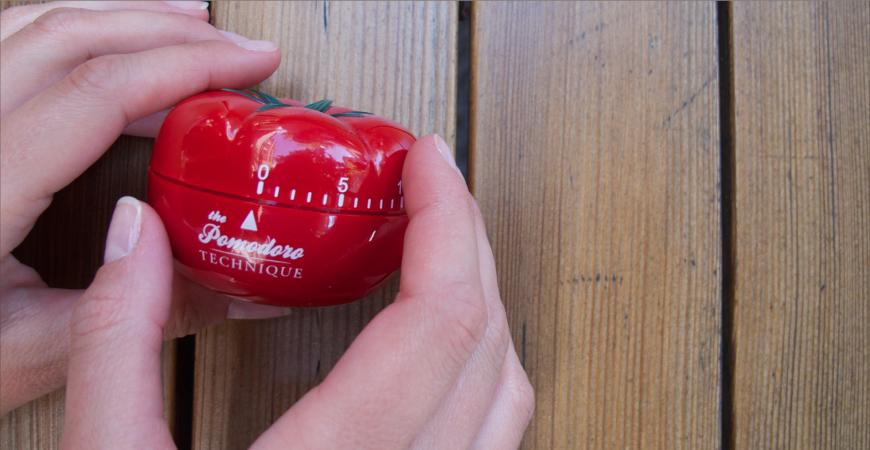The Pomodoro Technique - Taking breaks during sedentary activities can help reduce skin picking

Online test
Find out the severity of your symptoms with this free online test

Has anything like this happened to you?
- You suddenly become aware that time has passed and you have no idea how it happened?
- You’re in a class or a long meeting which does not require much participation and you come to awareness when someone pokes you to let you know it’s over?
- You’re binge-watching Netflix and realize you’ve eaten an entire bag of popcorn when you only wanted to eat half?
The scientific explanations for this phenomenon abound, however, for those who suffer from skin picking in an automated way, passive or sedentary activities can be triggers.
Online Test for Skin Picking
How Severe is Your Picking Disorder? Find Out With This Free Online Test
Take the testDissociation and “zoning out”
In simple terms, the situations described above are mild forms of dissociation. Some people refer to this as “zoning out,” while more severe versions can be diagnosed as a disorder. Think of dissociation along a continuum with mild zoning out and inattention at the less serious end and Dissociative Identity Disorder on the severe end. Dissociation can be the brain’s way of taking a break and can be caused by traumatic events or simply boredom.
People with excoriation disorder tend to have different methods for picking. Sometimes the behavior is focused and serves to resolve compulsions, but for others, picking occurs outside of awareness (Walthier, Flessner, Conelea & Woods, 2009). When this is the case, passive and sedentary activities can be triggers for picking behaviors and increases the likelihood of someone picking when they do not really want to.

Minimize zoning out
Just because your brain becomes bored during passive or sedentary activities does not mean dissociation always happens. For those who find themselves picking at their skin when their brain disengages, the possibility of it happening outside of awareness at an inappropriate time is stressful. At some point, however, you’ve probably figured out if skin picking behaviors worsen when you zone out, so that is a good first step to making sure it doesn’t happen when you don’t want it to.
Here are some things you can do:
- Minimize lengthy periods of passivity by taking control of your schedule.
- Plan for unavoidable potential boredom.
- Keep your hands busy. Doodle or draw, write notes, use a fidget spinner, hold beads or a coin, squeeze a stress ball.
- Use technology to “wake” you up. If you have a smartwatch or smart phone, set it to vibrate every 15 minutes to make sure you’re aware of your surroundings.
- Take breaks. Other people do not need to know why you’re taking a break or where you’re going. If you’re in a meeting or class and you find yourself zoning out, take a bathroom break or a walk in the hall.
Stress-motivated dissociation
When faced with stress or anxiety, the brain can decide to take its own vacation as a way to manage the stress. Consider when you have a large project due at school or work and the deadline is looming over you. The project needs to get done, but you feel like there is no way you can do it. Fretting causes overload and your brain checks out. Situations like these can be triggers for people who pick their skin as an emotional regulation response, a soothing reaction to reduce stress, or as an automatic response when the brain checks out.
The Pomodoro Technique
Whether your goal is to manage something passive, boring, or stressful, the Pomodoro Technique may be something to try. It was developed by entrepreneur Francesco Cirillo as a way to track his work while improving productivity (Cirillo, 2006). The goal of the technique is to break large amounts of time or tasks into smaller, more manageable pieces in an effort to reduce anxiety, increase awareness, enhance focus, and boost motivation.

Using the example of the looming project deadline, it may seem insurmountable to finish the whole thing. The Pomodoro Technique invites you to break it into smaller pieces and focus on those instead of the whole. The question to ask yourself is, “Could I do 30 minutes of research on this project?” or “Can I create the outline for the presentation today?” Once those tasks are complete, reward yourself in a healthy and appropriate way and then do the next small part.
The same principles apply for getting through boring activities. Maybe this meeting you have to attend is expected to be 3 hours long. Can you get through 45 minutes without zoning out? Plan to take a break at those time intervals or whatever interval feels comfortable to you. Or set your smartwatch to vibrate on your wrist every 15 minutes. Can you pay attention for one 15-minute interval? Then take a break and try another 15 minutes. When you’re binge-watching Netflix, make a point of getting up and doing something active following each television episode or movie. If sitting sedentary for a whole movie is too long, use a 30-minute timer as a reminder to take breaks.
The beauty of using something like the Pomodoro technique is its flexibility. It can be tailored to what works best for you. For some people, breaking time into 10-minute chunks is more manageable while others can do 45 minutes. The idea is to experiment until you find something that works for you.

Finally, celebrate your success! When breaking one large goal into the smaller task- or time-oriented goals, it is important to celebrate your success along the way. There is a reason video games are designed with small incentives and achievements earned on the way to leveling up or finishing the game. Small rewards that build up to bigger rewards, whether they are tangible or intangible, keep us motivated to improve further.
References
Cirillo, F. (2006). The Pomodoro Technique. Retrieved from http://www.baomee.info/pdf/technique/1.pdf
Walthier, M. R., Flessner, C. A., Conelea, C. A., & Woods, D. W. (2009). The Milwaukee Inventory for the Dimensions of Adult Skin Picking (MIDAS): Initial development and psychometric properties. Journal of Behavior Therapy and Experiemental Psychiatry, 40(1), 127-135. Doi: 10.1016/j.jbtep.2008.07.002
Online test
Find out the severity of your symptoms with this free online test
Start your journey with SkinPick
Take control of your life and find freedom from skin picking through professional therapy and evidence-based behavioral techniques.
Start Now



